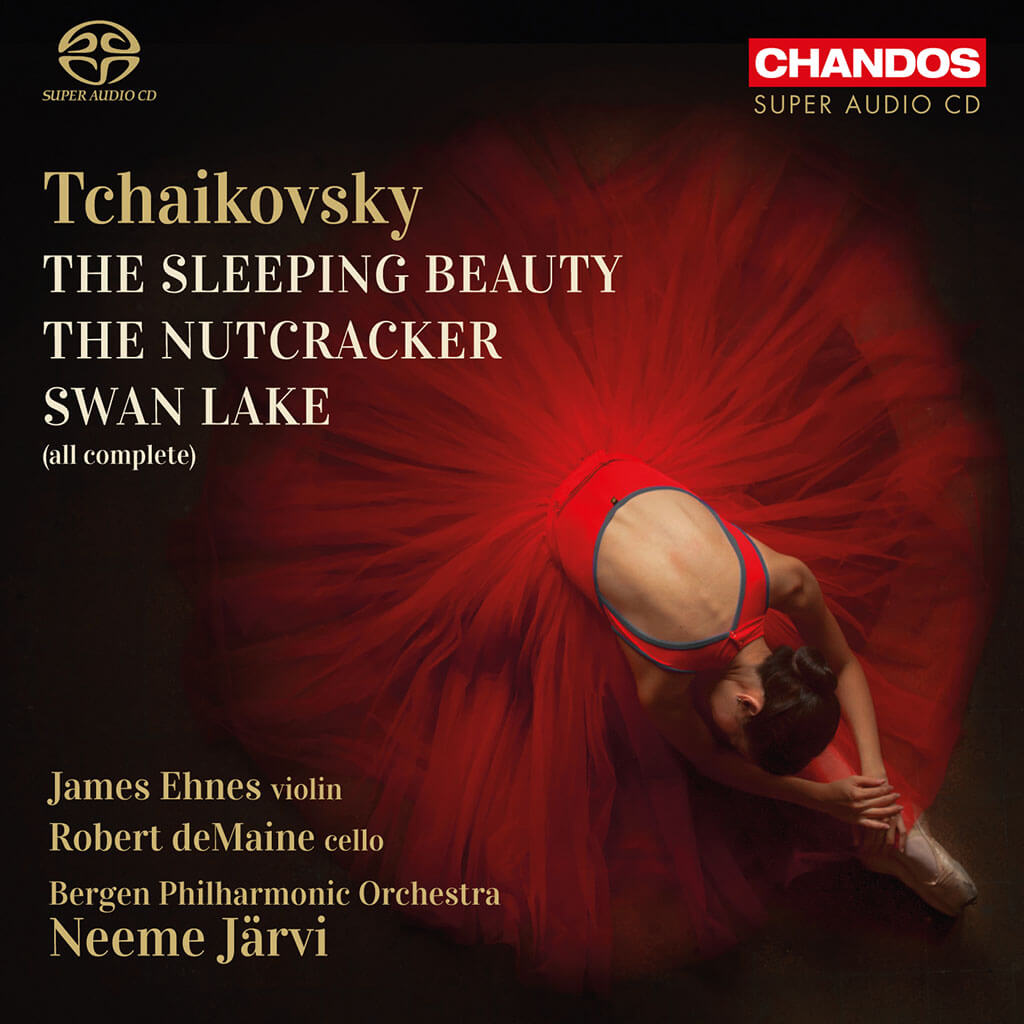
Here you have all three of Tchaikovsky’s great ballet scores gathered together in one box, in superlative performances and with recorded sound that is uncommonly rich and full. As a bonus you have some luxury casting for the violin solos in Swan Lake and The Sleeping Beauty: James Ehnes, no less, a Canadian by birth but an international star by any standard. These performances were recorded between 2012 and 2014 and released separately. Their latest incarnation, issued to commemorate Neeme Järvi’s 80th birthday (June 17, 2017), deserves a warm welcome.
While these Tchaikovsky scores have become immensely popular or even beloved over the years, too often we hear them played by ballet orchestras with too few players, and musicians who have played this music too often to be inspired by it. Pity the ballet orchestra conductors too. In most cases they are at the mercy of the choreographer who is more concerned with the movements of his or her dancers than with the notes in the score. In many companies tradition has a stranglehold. The present director does what his predecessor did or what they have always done at the Bolshoi or the Royal Ballet. Sometimes this tradition is based on recordings or piano scores used for rehearsal. When it comes to classics like Swan Lake or the The Nutcracker the conductor has no choice but to follow the tradition. Not so for concert performances or recordings. More than a hundred years after the premieres of these works there is no way we can determine exactly what Tchaikovsky or the choreographer Petipa had in mind in the way of tempos. But we can study the scores and other works by Tchaikovsky and reach an understanding of the composer’s style. In Neeme Järvi we have a conductor steeped in Russian music-making from the time he first learned to read music. He was born in Tallinn, Estonia and studied at the Leningrad Conservatory under Mravinsky and Rabinovich. He commands an enormous repertoire but he is especially authoritative in Russian music. He conducts these ballet scores with obvious love for the music but also with expansive phrasing and a keen ear for telling details.
Neeme Järvi is a man of enormous charm with a mischievous sense of humour. One might call him “the Estonian Sir Thomas Beecham” for these qualities but also for his conducting spontaneity and for his mastery of miniatures. While he was conductor of the Detroit Symphony Järvi played an encore at every concert. Some were familiar, but others, as in Beecham’s case, were unknown gems neglected by other conductors. The great Tchaikovsky ballet scores are really a series of such miniature pieces. Some are character pieces lasting only a minute or so to feature colourful characters or groups e.g. the Chinese Dance in The Nutcracker, the Dance of the Diamond Fairy in The Sleeping Beauty, or the Dance of the Little Swans in Swan Lake. Järvi has a genius for bringing such pieces to life with an amazing range of colour and expression. But in the big moments Järvi is no slouch either. Time and again he has the Bergen Philharmonic sounding like the Leningrad Philharmonic from the Mravinsky days with playing of astonishing power and precision.
Listening to these recordings I marveled again at the composer’s limitless ingenuity. There is a lot of ballet music that is simply workaday material churned out to accompany the dancers without much intrinsic value in itself. Not so with Tchaikovsky. He manages to come up with one fresh idea after another and his resourcefulness in matters of orchestration is remarkable. Instruments are used in surprising combinations and with a keen understanding of what they can do. It was in these scores, especially The Sleeping Beauty, where the harp really came into its own as an orchestral instrument. Harpist Johannes Wik is featured in these performances and plays magnificently. The violin solos in The Sleeping Beauty and Swan Lake provide further examples. They are beautiful pieces in themselves, quite apart from their usefulness in ballet performances. The Swan Lake solos in particular are often played as concert pieces. I note that a new recording by violinist Esther Yoo with conductor Vladimir Ashkenazy includes two of them along with the Violin Concerto (DG 4815032). They are certainly worthy of the attention of the greatest violinists for their technical demands and memorable melodies. James Ehnes is such a violinist and he plays them with gorgeous tone and impeccable technique. Note to Toronto concertgoers: James Ehnes will make an appearance on July 17 at Koerner Hall during Toronto Summer Music.
There have been many fine recordings of these Tchaikovsky ballet scores—the recordings by Dorati and the Concertgebouw Orchestra stand out in my memory—but these Chandos versions are surely among the best of them. The quality of the recorded sound is particularly impressive. Kudos to producer Brian Pidgeon and chief engineer Brian Couzens, but also to the Grieghallen, the fine 1,500 seat hall in Bergen where the recordings were made. The Grieghallen is also the home of the Bergen Philharmonic.
For more RECORD KEEPING, see HERE.
#LUDWIGVAN
- SCRUTINY | TSO Lets Berlioz Do The Talking In Season Opener - September 21, 2018
- RECORD KEEPING | Even Yannick Nézet-Séguin Can’t Make Us Love Mozart’s La Clemenza di Tito - September 6, 2018
- RECORD KEEPING | Giovanna d’Arco With Anna Netrebko Explains Why The Best Operas Survive - August 30, 2018



